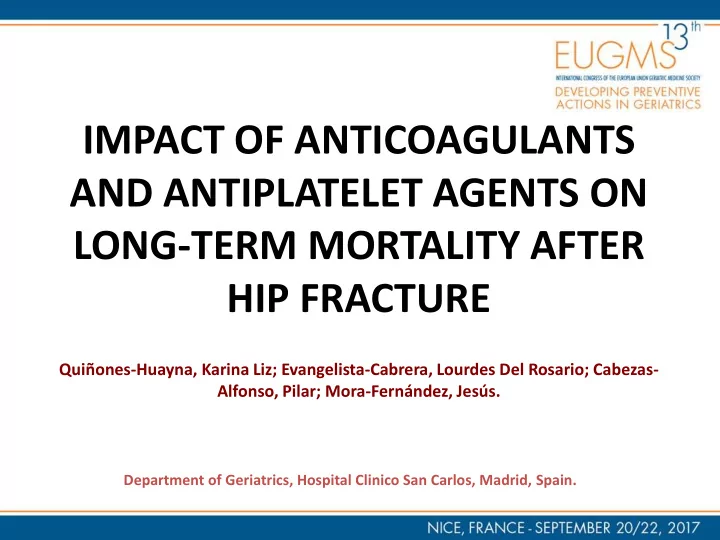

IMPACT OF ANTICOAGULANTS AND ANTIPLATELET AGENTS ON LONG-TERM MORTALITY AFTER HIP FRACTURE Quiñones-Huayna, Karina Liz; Evangelista-Cabrera, Lourdes Del Rosario; Cabezas- Alfonso, Pilar; Mora-Fernández, Jesús. Department of Geriatrics, Hospital Clinico San Carlos, Madrid, Spain.
CONFLICT OF INTEREST DISCLOSURE we have no potential conflicts of interest to report
BACKGROUND The use of anticoagulants and antiplatelet agents in older people has been rising in relationship to the increasing prevalence of cardiovascular and thromboembolic diseases as appropriate prescription according to STOPP START criteria. Anaemia is mentioned in the literature as a factor associated with increased morbidity and mortality.
OBJECTIVE To evaluate the impact of preoperative anticoagulant and antiplatelet therapy on the long-term mortality of hip fracture patients. To evaluate the predictors by one year mortality.
METHODS(1) Jan 2015 – Feb 2016 418 patients 1 year follow-up study Consecutive patients over 65 admitted with hip fracture n=406 Phase 1: Data collection: Phase 2: Demographic data. Mortality at 1-year Functional (Barthel Index, Functional ambulation classification, follow-up. Lawton index). Comorbidity (Age-adjusted Charlson comorbidity index ). Time to surgery . Use and type of Anticoagulants and antiplatelet agents, Haemoglobin at admission , lowest haemoglobin level, blood transfusion. Complications. length of stay.
METHODS(2) • STATISTICAL ANALYSIS: Chi-square and Mann-Whitney U test, Kaplan-Meier survival curves, Cox regression model. SPSS 23.0.
RESULTS BASE-LINE CHARACTERISTICS Mean Age 84.9 (SD 7.2) Female 79.9% (334) Age-adjusted Charlson comorbidity index 6.1 (IQR 5.0-7.6) Cognitive impairment 43.5% (182) Barthel Index 85 (IQR 65 - 95) Functional ambulation classification 4 (IQR 3 - 5)
RESULTS GENERAL CHARACTERISTICS Time to Surgery (days) 3.8 (IQR 2.1 – 5.3) Length of Stay (days) 9.3 (IQR 6.4 – 14.7) Haemoglobin at admission 12.7 (IQR 11.4 -13.7) time(mg/dl) Lowest Haemoglobin Level(mg/dl) 8.7 (IQR 8.2- 9.7) Haemoglobin at discharge mg(dl) 10.5 (IQR 9.9 -11.1) Preoperative Blood Transfusion 24.7% (103)
USE OF ANTICOAGULANTS AND ANTIPLATELETS AGENTS AAS 100 mg 76.9% AAS 300 mg 9% Clopidogrel 75mg 9% 34.4% Others 5.1% 49.8% 15.8% Acenocoumarol 86.2% NOADs 12.3% LMWHeparin 1.5% NONE ANTICOAGULANTS ANTIPLATELET AGENTS
Univariate Analysis Variables p Gender: male P<0.001 > Age p <0.001 > Length of stay p = 0.002 < Barthel index p = 0.004 < Functional ambulation classification p = 0.006 < Lawton index p =0.008 > Age-adjusted Charlson comorbidity index p <0.001 < Haemoglobin at admission p = 0.04 > Complications p <0.001
Kaplan Meier Analysis Mortality rate: Cummultative survival • 1 month: 4.3%. • 6 months: 11.6%. • 1 year: 14.1%. Time in days
Kaplan Meier Analysis None medication. p=0.66 Anticoagulants. Antiplatelet agents. Cummultative survival 1 month 3 months 6 months 1 year None medication 3.3% 4.3% 7.7% 9.8% Anticoagulants 3.4% 11.9% 13.6% 15.3% Antiplatelets 5.1% 11.3% 14.7% 18.5% Time in days
PREDICTORS OF ONE YEAR MORTALITY IN MULTIVARIATE ANALYSIS. B Sig Exp (B) Gender: Male 0.781 0.010 2.184 Age-adjusted Charlson comorbidity index 0.254 <0.001 1.289 Impaired renal function 0.975 0.001 2.650 Delirium 0.711 0.030 2.037
CONCLUSIONS There was no association between use of anticoagulants and antiplatelet agents and mortality at 1-year follow-up in our sample. Gender(male), comorbidity, and specific complications (delirium, Impaired renal function) were the main predictive factors of mortality.
THANK YOU
Recommend
More recommend